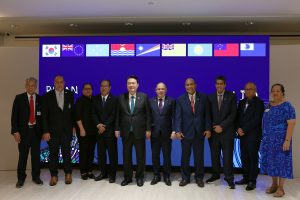Seoul’s rapprochement with Tokyo and efforts to deepen trilateral cooperation between South Korea, Japan, and the United States have garnered much of the attention in South Korea’s foreign policy this year. Less noticed, however, have been Seoul’s efforts to deepen cooperation with the Pacific Island states.
Prior to the Yoon administration, diplomatic engagement between South Korea and the 14 Pacific Island states was minimal. Diplomatic engagement was limited to the foreign minister and senior official levels. Even those contacts consisted of only four foreign minister level meetings since 2011.
South Korean aid to the region was similarly sparse. Official development assistance (ODA) to Oceania, which includes the Pacific Island states along with Australia and New Zealand, accounted for 0.8 percent of Seoul’s ODA, or just $16.42 million, in 2021. Additionally, according to data from the Korea International Cooperation Agency, none of the Pacific Island states was among the top 20 recipients of Korean ODA in 2021.
In contrast to prior administrations, the Yoon administration has worked to integrate the region into its broader foreign policy strategy at the bilateral, trilateral, and regional level.
In late May, South Korea hosted the first Korea-Pacific Islands summit where the leaders discussed deepening cooperation in the areas of climate change, disaster risk and resilience, sustainable development, and maritime affairs and fisheries. As part of deepening cooperation and dialogue with the region, Seoul announced that it would increase the number of embassies it has in the region. It also committed to double by 2027 the development assistance it provides the Pacific states.
The leaders also developed an action plan focused on resilience, reinforcement, and revitalization. The action plan includes commitments by South Korea to assist the Pacific states with enhancing their climate prediction systems, initially including five states for climate sensitive sectors such as agriculture and water management. Additional climate related projects include working with the Pacific Island states on the development of green energy projects, forest management to help prevent costal erosion and deal with storm surges, and improving the region’s ability to monitor ocean acidification. The action plan additionally calls for cooperation on capacity building in the region and infectious disease management.
The summit, although successful, was overshadowed by great power competition. Solomon Islands, which recently established a new security partnership with China, issued a separate statement distancing itself from the overall summit statement. Solomon Islands Prime Minister Manasseh Sogavare said that his country would not engage in geopolitics. The root of the dispute was the inclusion of a reference to South Korea’s own Indo-Pacific strategy in the summit declaration.
In its Indo-Pacific strategy, South Korea calls for deepening engagement with the Pacific Island countries on climate change, renewable energy, healthcare, and oceans and fisheries issues. This includes the provision of green ODA projects to support the region’s low-carbon energy transition. All these aspects align with Korean commitments at the Pacific States summit in Seoul.
South Korea followed up on the progress made in Seoul with a second meeting between Yoon and Pacific Island leaders, this time in the form of a luncheon on the sidelines of the United Nations General Assembly in New York. The meeting on September 22 brought together the South Korean president and leaders from Cook Islands, Kiribati, Micronesia, Niue, Palau, the Republic of Marshall Islands, and Samoa, as well as the secretary-general of the Pacific Islands Forum.
In addition to engaging bilaterally, South Korea is also engaging the states of the Pacific Islands with partners. Last year, South Korea took part in a meeting of the Partners in the Blue Pacific, an initiative by the United States, Australia, Japan, and the United Kingdom to collaborate on regional development in Oceania guided by the Pacific Islands Forum’s 2050 Strategy for the Blue Pacific Continent. South Korea has now joined the Partners in the Blue Pacific as a full partner and took part in the grouping’s second meeting this year, which reached agreements to work with the Pacific Island states on pre-positioning humanitarian and emergency supplies for the region, cybersecurity, and fishing and maritime domain awareness.
Cooperation with the Pacific Island states is also part of the renewed trilateral cooperation between the United States, South Korea, and Japan, exemplified by the summit at Camp David in August. There, the three leaders agreed to collaborate on strengthening regional architecture, including the Pacific Islands Forum, and to focus on maritime cooperation with the region.
South Korea’s efforts to engage the Pacific Island states are still nascent; there is more that could be done to enhance it. While it is commendable that Seoul intends to double its ODA to the region, there is scope to further increase that aid. Some of that increase could come though deeper cooperation in projects with the Partners in the Blue Pacific, but an additional increase in bilateral aid seems feasible if coordinated with the region’s own 2050 strategy.
With cooperation now embedded within South Korea’s own Indo-Pacific strategy, the Partners in the Blue Pacific, and trilateral cooperation with the United States and Japan, the Pacific Island states will likely continue to be a more prominent part of Seoul’s foreign policy in the years ahead.

































